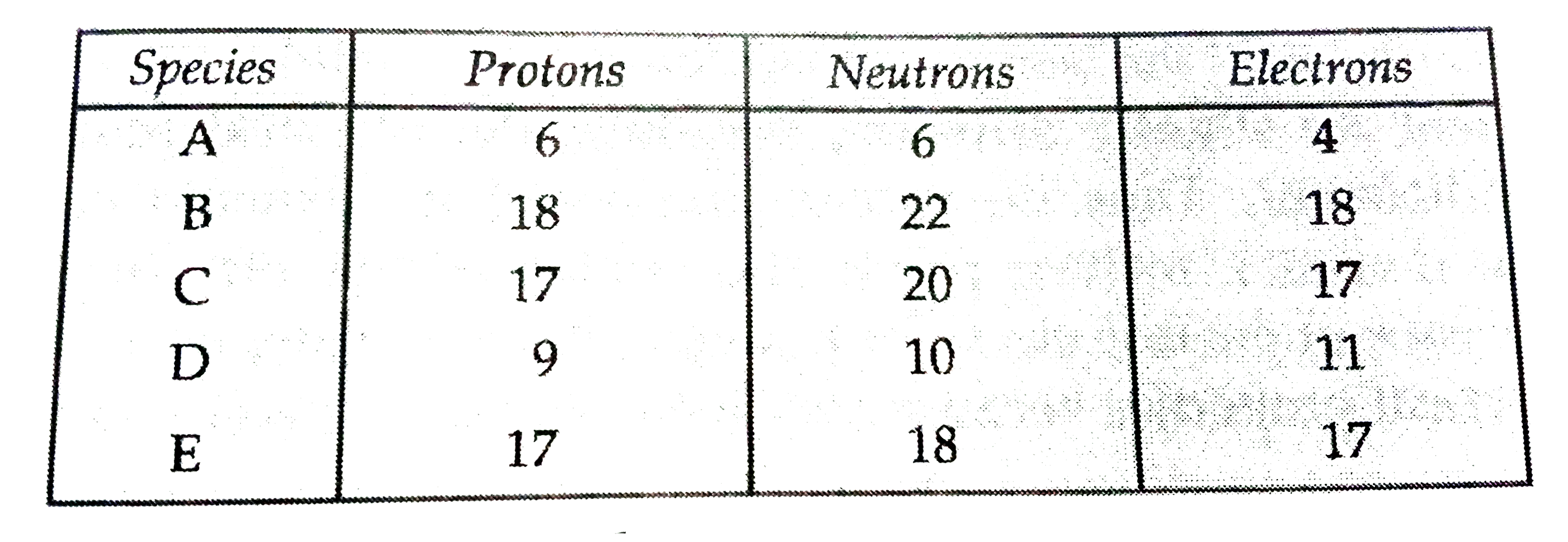The number of protons, neutrons and electrons in particles A to E are given below :
ParticleProtonsNeutronsElectronsA171817B342C182218D172017E91010
Giving reasons, find a pair of isotopes from the above particles.
The correct Answer is:A and D ; Same number of protons but different number of neutrons
Step by step video, text & image solution for The number of protons, neutrons and electrons in particles A to E are given below : {:("Particle","Protons","Neutrons","Electrons"),("A",17,18,17),("B",3,4,2),("C",18,22,18),("D",17,20,17),("E",9,10,10):} Giving reasons, find a pair of isotopes from the above particles. by Chemistry experts to help you in doubts & scoring excellent marks in Class 9 exams.
Topper's Solved these Questions
- BOOK - LAKHMIR SINGH & MANJIT KAURCHAPTER - STRUCTURE OF ATOMEXERCISE - Very Short Answer1videos
STRUCTURE OF ATOM
- BOOK - LAKHMIR SINGH & MANJIT KAURCHAPTER - STRUCTURE OF ATOMEXERCISE - NCERT Book, Page 501videos
STRUCTURE OF ATOM
- BOOK - LAKHMIR SINGH & MANJIT KAURCHAPTER - STRUCTURE OF ATOMEXERCISE - Value Based Questions17videos
STRUCTURE OF ATOM
- BOOK - LAKHMIR SINGH & MANJIT KAURCHAPTER - MODEL TEST PAPER 5EXERCISE - Section B2videos
MODEL TEST PAPER 5
Similar Questions
Knowledge Check
- Question 1 - Select One
The charge on the atom having 17 protons, 18 neutrons and 18 electrons is
A+1B−1C−2DZero - Question 2 - Select One
The charge on the atom containing 17 protons, 18 neutrons and 18 electrons is.
A+1B−1C−2DZero - Question 3 - Select One
The charge on the atom containing 17 protons, 18 neutrons and 18 electrons is.
A+1B−2C−1Dzero
Name the particle which has 18 electrons , 18 neutrons and 17 protons in it.
View SolutionThe charge on the atom having 17 protons, 18 electrons is
View SolutionTwo particles (X) and(Y) have the comostion as shown in the table :
particlenumberof electonsnumber of neutrous Number of protons(X)181616(Y)181817
the paricle (x) and(Y) are:View SolutionThe atom of an element has 18 neutrons and 17 protons. The atomic mass of the elements is
View SolutionThe number of protons, neutrons and electrons in four elements 1, 2, 3 and 4 are as follows:
(1) p = 6, n = 6, e = 6
(2) p = 6, n = 7, e = 6
(3) p = 18, n = 22, e = 18
(4) p = 19, n = 21, e = 19
In these
View Solution


